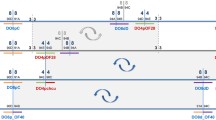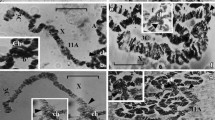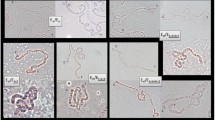Abstract
The strain of Drosophila melanogaster In (1)m k; In (2LR) Rev B shows more miniature variegation than the strain In(1)m K and less Revolute variegation than the strain In(2LR)Rev B. Observations on heterochromatisation in the larval salivary gland chromosomes of the three strains revealed that the m k chromosome is heterochromatised in a higher proportion of nuclei and the Rev B chromosome is heterochromatised in a lower proportion of nuclei in the double-inversion strain than in the corresponding single-inversion strain. Single-and double-inversion strains did not however differ in the mean number of bands heterochromatised per affected chromosome. The difference between incidence and extent of heterochromatisation was further exposed by comparisons between and within strains: the incidence of heterochromatisation in different chromosome regions within a nucleus was positively correlated, but a significant positive correlation was found in only one of the eight possible comparisons between extents of heterochromatisation in different chromosome regions in a given nucleus, two of the comparisons showing significantly negative correlations. The results in general are compatible with the view that the initiation and progression of heterochromatisation are distinct phenomena, under separate control.
Similar content being viewed by others
References
Baker, W.K.: Genetic control of pigment differentiation in somatic cells. Amer. Zoologist 3, 57–69 (1963)
Baker, W.K.: A clonal system of differential gene activity in Drosophila. Develop. Biol. 16, 1–17 (1967)
Baker, W.K.: Position-effect variegation. Advanc. Genet. 14, 133–169 (1968)
Becker, H.J.: Über Röntgenmosaikflecken und Defektmutationen am Auge von Drosophila und die Entwicklungsphysiologie des Auges. Z. indukt. Abstamm.- u. Vererb.-L. 88, 333–373 (1957)
Becker, H.J.: Untersuchungen zur Wirkung des Heterochromatins auf die Genmanifestierung bei Drosophila melanogaster. Verh. dtsch. Zool. Ges. Bonn-Rhein. Zool. Anz. Suppl. 24, 283–291 (1961)
Bridges, C.B.: Salivary chromosome maps. J. Hered. 26, 60–64 (1935)
Bridges, C.B.: A revised map of the salivary gland X-chromosome of Drosophila melanogaster. J. Hered. 29, (Suppl.), 11–13 (1938)
Chen, S.Y.: Action de la température sur trois mutants a panachure de Drosophila melanogaster: w258-18, wm5 and z. Bull. Biol. France et Belg. 82, 114–129 (1948)
Demerec, M.: The nature of changes in the white-Notch region of the X-chromosome of Drosophila melanogaster. Proc. 7th Int. Congr. Genetics, 99–103 (1941)
Dobzhansky, Th.: Distribution of heterochromatin in chromosomes of Drosophila pallidipennis. Amer. Naturalist 78, 193–213 (1944)
Hartmann-Goldstein, I.J.: On the relationship between heterochromatisation and variegation in Drosophila, with special reference to temperature-sensitive periods. Genet. Res. (Camb.) 10, 143–159 (1967)
Janning, W.: Bestimmung des Heterochromatisierungsstadiums beim white-Positionseffekt mittels röntgeninduzierter mitotischer Rekombination in der Augenanlage von Drosophila melanogaster. Molec. gen. Genet. 107, 128–149 (1970)
Lewis, E.B.: The phenomenon of position effect. Advanc. Genet. 3, 73–115 (1950)
Noujdin, N.I.: Hereditary changes and ontogenesis. Zh. obshch. Biol. 6, 381–410 (1945)
Schultz, J.: The relation of the heterochromatic chromosome regions to the nucleic acids of the cell. Cold Spr. Harb. Symp. quant. Biol. 21, 307–328 (1956)
Taylor, J.H.: Regulation of DNA replication and variegation-type position effects. Symp. Int. Soc. Cell Biol. 3, 175–190 (1964)
Wargent, J.M.: Position-effect variegation in wings of Drosophila melanogaster. Dros. Inf. Serv. 47, 91 (1971)
Wargent, J.M.: Position-effect variegation in the Revolute of Bridges strain of Drosophila melanogaster. Dros. Inf. Serv. 49, 50–51 (1972)
Wargent, J.M., Hartmann-Goldstein, I.J.: Phenotypic observations on modification of position-effect variegation in Drosophila melanogaster. Heredity 33, 317–326 (1974)
Wargent, J.M., Hartmann-Goldstein, I.J., Goldstein, D.J.: Relationship between DNA content of polytene chromosome bands and heterochromatisation in Drosophila. Nature (Lond.) 248, 55–57 (1974)
Author information
Authors and Affiliations
Rights and permissions
About this article
Cite this article
Hartmann-Goldstein, I.J., Wargent, J.M. Cytological observations on the interaction between two inversions responsible for position-effect variegation in Drosophila melanogaster . Chromosoma 52, 349–362 (1975). https://doi.org/10.1007/BF00364019
Received:
Accepted:
Issue Date:
DOI: https://doi.org/10.1007/BF00364019




